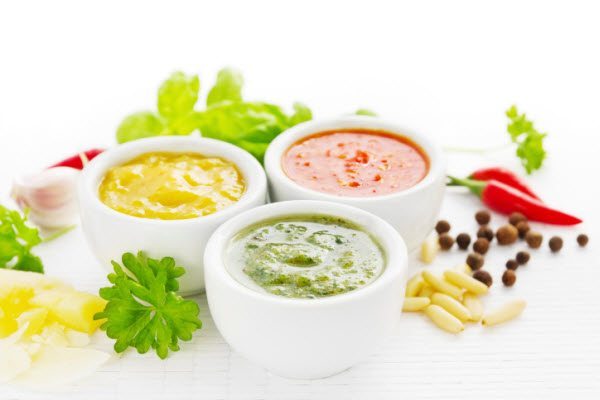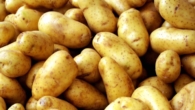
Sauces and seasonings: good and bad
0
Spices, spices , sauces and seasonings have been used by mankind since ancient Egypt, India and China. They create a special aroma, taste and appearance of dishes from chefs from different countries of the world. In addition, many of them have important and often underestimated beneficial properties for our health. But the opposite also happens: certain seasonings and sauces can contain, and often in significant quantities, harmful ingredients, in particular, salt, sugar, food additives.
If you try to make a list of only those spices, sauces and seasonings with a positive effect on health, then it is worth including the following examples, which are characterized by an optimal combination of taste and nutritional value:
PESTO
Due to its high zinc content, pesto should be considered by vegetarians, who need 50% more zinc per day due to reduced absorption of zinc from plant sources. At the same time, this sauce may not be suitable for strict vegetarians, as the cheese in it is often made using rennet obtained from the stomachs of calves.
Pesto can be added to baked chicken, used as a pasta sauce or spread on whole grain bread .
SALSA
Low-calorie tomato sauce. Two tablespoons (30 ml) of salsa contain only 10 calories. It is a healthy alternative to high-calorie salad dressings, and will also taste good with scrambled eggs. Pay attention to the label and choose low-salt, sugar-free salsa.
TAHINI
Tahini is a Middle Eastern sauce made from ground sesame seeds. It is especially rich in vegetable protein. 2 tablespoons (30 ml) of tahini provide more than 5 grams of this nutrient—or 8% of the BDI for an 80 kg adult.
Tahini is delicious as a homemade salad dressing, or spread on toast , adding a pinch of cinnamon.
MUSTARD
Mustard is made from mustard seeds, distilled vinegar, garlic powder, turmeric, lemon juice and salt. It is low in calories: 2 teaspoons (10 grams) of yellow mustard has only 6 calories. In addition, most varieties of mustard contain turmeric. Curcumin, found in turmeric, has shown strong anti-inflammatory benefits in many studies.
Mustard is a healthy addition to homemade salad dressings, marinades, and eggs. It also gives a fragrant crust when baking salmon or chicken.
KIMCHI
A popular Korean dish made from fermented vegetables. There are many varieties of kimchi, but the main ingredients are usually cabbage, garlic, onion, chili pepper, and salt.
Kimchi can be used to make noodles, rice, or sandwiches.
FERMENTED CABBAGE
Low-calorie product, 50 grams contains about 8 calories. Sauerkraut is also rich in beneficial probiotics, with over 28 different probiotic bacterial strains found in one study.
Sauerkraut can be added to a salad or sandwich.
HUMUS
Hummus tastes great with vegetables, pita bread, and can be used as a healthier alternative to mayonnaise.
GUACAMOLE
Guacamole replaces salad dressing, it can be spread on toast or used as a hearty vegetable dip.
GREEK YOGURT< /strong>
Is the best healthy alternative to most cream-based condiments. Classic Greek yogurt, without added sugar, may be the best option.
Use Greek yogurt instead of sour cream or mayonnaise. It can be added to baked potatoes or homemade vegetable sauce.
PEANUT BUTTER
Nut butters, such as peanut and almond butter, can be a nutritious addition to many meals and snacks. Nut butter is rich in protein: 2 tablespoons (32 grams) provide an average of 7 grams of protein. The same serving contains about 25% of the basic daily value of magnesium, a mineral necessary for dozens of biochemical reactions in the body.
Nut butter, like peanut, almond and cashew, is delicious with toast or crackers. Look for nut butters without added sugar and enjoy them in moderation.
APPLE VINEGAR
Apple cider vinegar is made from fermented apple juice. It can improve blood sugar control after meals, which is especially beneficial for diabetics.
Add a splash of apple cider vinegar to a green leafy salad, mix it into a homemade salad dressing, or use it in a spicy marinade.
HONEY
Unpasteurized and minimally processed honey is rich antioxidants that help prevent cell damage in your body caused by free radicals. It also contains anti-inflammatory and antibacterial compounds.
Honey can be used to sweeten tea, yogurt or fruit dishes. But the consumption of honey should be as limited as the use of sugar – in general, you should eat less than 25 grams per day of sugar, honey and other free sugars.
NUTRITION YEAST
It is a deactivated yeast that is often used as a seasoning in vegan cooking. They are characterized by a high content of vitamin B12, which is necessary for cell division, energy production and the functioning of the nervous system. Two tablespoons (10 grams) of nutritional yeast provide 200% of the basic daily value of vitamin B12. Some varieties of nutritional yeast are fortified with additional B vitamins during processing, which increases vitamin B12 content.
Nutritional yeast can be used as a non-dairy alternative to cheese in vegan soups and sauces. They can be sprinkled on scrambled eggs or baked potatoes.
BUTTER
This product does not have the best reputation. But it also has health benefits, especially if the cows were grass-fed. Compared to regular butter, butter from grass-fed cows can contain up to 500% more conjugated linoleic acid (CLA). It also contains more omega-3 fatty acids, known for their anti-inflammatory benefits.
Butter can be used to enhance the flavor and texture of vegetables, fish or with whole grain bread. It should be consumed in moderate amounts – 20-25 grams per day.
LEMON JUICE
A versatile and useful seasoning that can be used every day. Rich in vitamin C, the juice of one lemon provides 25% of the basic daily value of this vitamin. Vitamin C is a powerful antioxidant that benefits your skin, immune system, and heart health. The vitamin C in lemon juice also improves the absorption of iron from plant foods.
Lemon juice is a great addition to seafood, salad dressings and vegetable dishes.
BALSAMIQUE VINEGAR
Dark vinegar made from grapes. It is rich in antioxidants, including polyphenols such as flavonoids, gallic acid and caffeic acid. They protect cells from damage and prevent oxidation of LDL (atherogenic cholesterol), which helps reduce the risk of heart disease.
Spray vegetables with balsamic vinegar before roasting, mix it with olive oil to make a balsamic dressing for a salad or add to homemade bruschetta.
RED HOT SAUCE
Most varieties of this sauce contain chili or cayenne pepper, vinegar and salt. Hot sauce is a great way to add flavor without a lot of calories. One teaspoon (5 ml) of red hot sauce contains only 6 calories. In addition, capsaicin—a compound in chili peppers—has anti-inflammatory properties and may promote weight loss.
Hot sauce is added to many dishes, including scrambled eggs, baked potatoes, or meat.
SOFRITO SAUCE
This sauce is considered a mandatory component of the Mediterranean diet – one of the best models of healthy eating. The main ingredients of sofrito are: garlic, onions, peppers and tomatoes, which are cooked in olive oil.
The sauce is suitable for many dishes (pasta, legumes, poultry, etc.). Two servings of sofrito per week are recommended.
TOASTED SESAME OIL
Has a richer flavor than regular sesame oil.
Sesame oil has anti-inflammatory properties and probably helps to reduce the level of LDL (harmful cholesterol).
Toasted sesame oil is good to use as a finishing touch to cooking. For example, pour over steamed vegetables and noodles for a pronounced nutty flavor.
COLD-PRESSED OLIVE OIL
Known for its powerful nutritional properties. Numerous studies point to the benefits of using olive oil to support heart health and reduce inflammation. This is largely due to its rich antioxidant content, which helps reduce cell damage in your body.
The oil is best used in recipes that do not require processing to preserve its nutrients. For example, pour over boiled pasta, vegetables or seafood.
TAMARI
A Japanese sauce made from fermented soybeans. It differs from traditional soy sauce by its thicker texture, darker color and richer taste.
Tamari contains approximately 45% more protein than traditional soy sauce. Two tablespoons (30 ml) of tamari provide almost 4 grams of protein. Most types of this sauce are also gluten-free.
Tamari can be added to any dish instead of soy sauce. It makes a good dressing for salads and noodles. It is worth paying attention to the salt content in all types of soy sauces.
You should limit the use of sauces and seasonings with an excessive content of useless ingredients:
• Fat-free salad dressing. Despite being lower in calories, fat-free dressings often contain more added sugar and salt than their naturally fat counterparts.
• Barbecue sauce. This sauce often has a lot of added sugar, with 2 tablespoons (30 ml) containing over 11 grams (3 teaspoons).
• Sweet syrup. Often contains high fructose corn syrup (HFCS). Excessive consumption of HFCS has been linked to heart disease, obesity and type 2 diabetes. As a healthier alternative, use maple syrup.
• Margarine. Many margarine products contain traces of trans fats. Many studies have linked this type of fat to heart disease. Use healthy fats like olive oil or butter instead.
• Teriyaki sauce. High in sodium, just 2 tablespoons (30 ml) provide more than 60% of the basic daily value of this mineral. High-sodium diets have been linked to chronic diseases such as heart disease and stroke.
• Artificial sweeteners. Some studies have linked zero-calorie sweeteners to obesity.









Leave a Reply